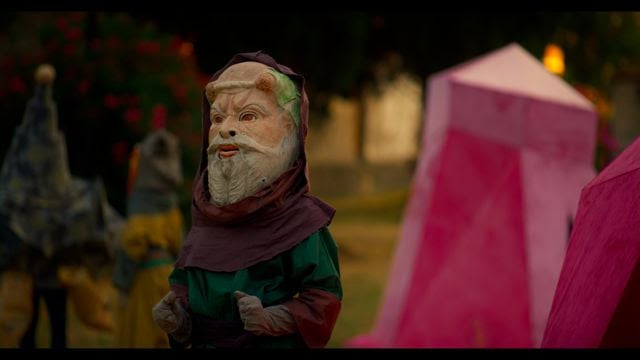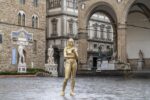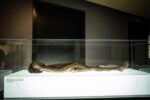Wael Shawky – I Am Hymns of the New Temples

Mostra personale dell’artista egiziano Wael Shawky dal titolo I Am Hymns of the New Temples.
Comunicato stampa
La Galleria Lia Rumma inaugura mercoledì 31 maggio 2023 alle ore 18:00, nella sede di Milano, la mostra personale dell’artista egiziano Wael Shawky dal titolo I Am Hymns of the New Temples.
Il titolo della personale di Shawky è tratto dalla sua nuova opera filmica presentata in anteprima internazionale il 12 maggio 2023 al Teatro Piccolo “Odeion” del Parco Archelogico di Pompei. L’installazione di Wael Shawky, che si sviluppa sui tre piani della galleria, ruota attorno alla proiezione del film I Am Hymns of the New Temples, girato nell’estate del 2022 tra le rovine di Pompei. L’antica città sepolta dalla cenere dell’eruzione del Vesuvio e poi riportata alla luce molti secoli dopo, è per Shawky un luogo simbolo di morte e rinascita di miti e riti, custode millenaria di una stratificazione di diverse culture che si richiamano le une con le altre e rivelatrice di come i molteplici resoconti della storia siano stati diversamente concepiti, registrati e diffusi nel corso del tempo al di qua e al di là delle sponde del Mediterraneo.
Nel film l’area archeologica di Pompei è come un teatro della memoria a cielo aperto, dove i suoi templi dedicati alla religione greco-romana convivono con quelli delle divinità egizie. Attraverso la ripetizione e la ri-narrazione poetica di racconti e storie mitiche sull’origine dell’universo e la nascita delle divinità della Terra, Shawky intreccia favola, realtà e finzione. Più tradizioni teogoniche si sono avvicendate nel mondo antico e l’artista affida ad un gruppo di performer che indossano maschere in ceramica e cartapesta, che si rifanno a quelle della commedia greca ma anche a quella popolare delle fabulae atellanae, il compito di riproporle, dando un volto a miti che una volta divennero credenze, per poi ridurli ancora una volta a finzione fantastica. Come la maschera trasforma chi la indossa in qualcun altro, così il culto e i riti misterici si trasformano a seconda di chi se ne appropria. In una sorta di danza misterica le figure di dei e dee, uomini e donne, insieme con animali, ripetono il lento e conflittuale processo attraverso cui il mondo ha cercato di trovare un suo equilibrio, tra guerre, conflitti e catastrofi naturali, in uno schema che si ripropone all’infinito, ieri come oggi, in un ciclo continuo di morte e rinascita dell’umanità.
Un racconto per immagini che dallo schermo prende corpo e forma nelle altre sale della galleria, altro teatro ideale di nuovi resti e reperti realizzati dall’artista e custoditi in grandi teche di vetro coperte di sabbia. Sono maschere-sculture in vetro e ceramica, anfore antropomorfe, alle quali si aggiungono bassorilievi, dipinti e disegni che ri-creano un’ambientazione mistica e profetica, che gioca ancora una volta a rimescolare i riferimenti storici, mitologici e letterari con cui l’artista ha immaginato la sua nuova storia del mondo. Shawky considera la tela come “uno spazio dove le finzioni diventano realtà” e su cui amplificare favolisticamente i regni del divino e terreno, invitando lo spettatore di oggi a navigare in una sorta di immaginaria epopea costellata da verità, miti e stereotipi, al di là di uno spazio e tempo definiti.
Wael Shawky (Alessandria d’Egitto, 1971) si è formato presso l’Università di Alessandria d’Egitto per poi conseguire un Master of Fine Arts presso la University of Pennsylvania a Philadelphia (USA).
Il lavoro di Wael Shawky ha origine da ricerche e viaggi intrapresi dall’artista nel suo paese natale e abbraccia le più disparate tecniche e media: dal disegno alla scultura, ma soprattutto film, performance e storytelling.
Nella poetica dell’artista queste tecniche vengono spesso combinate per creare un universo fiabesco ancorché reale in cui coesistono elementi della cultura araba tradizionale e immagini della contemporaneità: con uno sguardo fisso sulle vicende odierne, l’artista intraprende un percorso di rilettura dei caratteri culturali, religiosi ed artistici della storia medio-orientale, creando realtà altre e fantastiche che vivono e prosperano in luoghi immaginari. Celebre la sua trilogia filmica Cabaret Crusades – The Horror Show File (2010), The Path to Cairo (2012) e The Secrets of Karbala (2015) - in cui antiche marionette e burattini diventano i protagonisti delle storiche crociate medievali, narrate dall’artista con gli occhi del mondo arabo e con la leggerezza giocosa di una favola per bambini. Importanti mostre personali sono state dedicate all’artista da musei e istituzioni internazionali tra cui l’ARoS Museum, Aarhus, Danimarca; Castello di Rivoli Museo d’Arte Contemporanea, Rivoli, Italia; Kunsthalle Bregenz, Bregenz, Austria; Fondazione Merz, Torino, Italia; Mathaf, Arab Museum of Modern Art, Doha; il MoMA PS1, New York, USA; Tate Modern, Londra; M Leuven, Leuven, Belgio; Modern Art Museum of Fort Worth, Fort Worth, USA; Louvre Abu Dhabi, Abu Dhabi, UAE; MACBA, Barcellona, Spagna; K20, Beirut, Libano; Sharjah Art Foundation, Sharjah, UAE; The Hammer Museum, Los Angeles, USA; Kunst-Werke, Berlino, Germania; Cittadellarte-Fondazione Pistoletto, Biella, Italia; Kunsthalle Winterthur, Svizzera. Le sue opere fanno parte di collezioni permanenti di musei quali Tate Modern, MoMA, MACRO, Mart, The Met, APT Dubai, François Pinault Collection,Venice.
L’opera filmica I Am Hymns of the New Temples è stata commissionata dal Parco Archeologico di Pompei, nel contesto di Pompeii Commitment. Archeological Matters (Collectio).
Vincitrice dell’avviso pubblico PAC 2020 - Piano per l’Arte Contemporanea, promosso dalla Direzione Generale Creatività Contemporanea e Ministero della Cultura.
Opere in vetro realizzate da Berengo Studio, Venezia.
Opere in ceramica realizzate da Istituto Caselli Real Fabbrica di Capodimonte.
Tessuti forniti da Dedar, Annamaria Alois.
The Lia Rumma Gallery in Milan is delighted to announce that the first solo exhibition by the Egyptian artist Wael Shawky entitled I Am Hymns of the New Temples will open on Wednesday 31 May 2023.
The title of Shawky’s solo exhibition is taken from his new film which had its international premiere on 12 May 2023 at the Teatro Piccolo “Odeion” of the Archaeological Park of Pompeii.
Wael Shawky’s installation, which unfolds over the three floors of the gallery, revolves around the projection on the first floor of the film I Am Hymns of the New Temples, which was shot during the summer of 2022 among the ruins of Pompeii. The ancient city, buried beneath the ash of the eruption of Vesuvius and brought back to light many centuries later, is considered by Shawky to be a place that symbolises death and rebirth. He views it as a site of myth and ritual, the age-old custodian of the stratification of various cultures that evoke each other and reveal how the multiple narratives of history have been differently conceived, recorded and disseminated over time, both within and beyond the Mediterranean area.
In the film the archaeological site of Pompeii is portrayed as an outdoor theatre of the past where its temples dedicated to Greco-Roman religion co-exist with those of Egyptian deities. Through the repetition and poetic re-narration of mythological tales and stories about the origin of the universe and the birth of the deities of the Earth, Shawky weaves a narrative that brings together fable, reality and fiction. Various traditions concerning the origin and descent of the gods succeeded each other in antiquity. The artist entrusts a group of performers wearing masks made of ceramic and papier mâché, which draw on those of Greek comedy but also on the popular masks of Campanian farce (fabulae atellanae), with the task of reviving them, giving a face to myths that once became beliefs, before reducing them again to fiction and fantasy. Just as a mask transforms the wearer into someone else, the cult and mystery rites are transformed according to the person who appropriates them. In a sort of mystery dance, the figures of gods and goddesses, men and women, together with animals, repeat the slow, conflictual process by which the world has sought to create its own equilibrium amidst wars, conflicts and natural calamities, in a pattern that is repeated ad infinitum, in the past as in the present, in a never-ending cycle of death and rebirth of humanity.
This image-based account moves from the screen, taking on shape and form in the other rooms of the gallery, another ideal theatre of new ruins and finds created by the artist and kept in large glass display cases covered in sand. As well as these mask-cum-sculptures made of glass and ceramic - anthropomorphic amphorae – there are also bas reliefs, paintings and drawings that recreate a mystical, prophetic setting which once again plays with the idea of mixing up the historical, mythological and literary references with which the artist has imagined his new history of the world. Shawky considers the canvas as “a space where fiction turns into reality” and on which he can amplify the realms of the divine and the earthly like a fable, inviting the present-day viewer to navigate in a kind of imaginary epic poem dotted with truth, myth and stereotypes, beyond defined space and time.
Wael Shawky (Alexandria, 1971) studied at Alexandria University before taking a Master’s Degree in Fine Arts at the University of Pennsylvania in Philadelphia (USA).
Wael Shawky’s work originates in research and journeys undertaken by the artist in his native country and embraces a plethora of techniques and media, ranging from drawing to sculpture, but focusing mainly on film, performance and storytelling.
In the artist’s poetic, these techniques are often combined to create a fairy-tale yet real universe in which elements of traditional Arab culture and images of the contemporary world co-exist: with his gaze firmly focused on current events, the artist embarks on a voyage in order to reinterpret the cultural, religious and artistic features of Middle-Eastern history, creating other fantastic realities that thrive and prosper in imaginary places. Shawky is renowned for his film trilogy Cabaret Crusades – The Horror Show File (2010), The Path to Cairo (2012) and The Secrets of Karbala (2015) - in which ancient marionettes and puppets become the main characters of the medieval crusades, recounted by the artist from the perspective of the Arab world and the playful lightness of a fairy-tale for children. Major solo exhibitions of the artist’s work have been held in international museums and institutions including the ARoS Museum, Aarhus, Denmark; Castello di Rivoli Museo d’Arte Contemporanea, Rivoli, Italy; Kunsthalle Bregenz, Bregenz, Austria; Fondazione Merz, Turin, Italy; Mathaf, Arab Museum of Modern Art, Doha; MoMA PS1, New York, USA; Tate Modern, London; M Leuven, Leuven, Belgium; Modern Art Museum of Fort Worth, Fort Worth, USA; Louvre Abu Dhabi, Abu Dhabi, UAE; MACBA, Barcelona, Spain; K20, Beirut, Lebanon; Sharjah Art Foundation, Sharjah, UAE; The Hammer Museum, Los Angeles, USA; Kunst-Werke, Berlin, Germany; Cittadellarte-Fondazione Pistoletto, Biella, Italy; Kunsthalle Winterthur, Switzerland. His works are displayed in the permanent collections of museums such as Tate Modern, MoMA, MACRO, Mart, The Met, APT Dubai, and the François Pinault Collection, Venice.
The film work I am Hymns of the New Temples was commissioned by the Pompeii Archaeological Park as part of Pompeii Commitment. Archeological Matters (Collectio). Winner of the public notice PAC 2020 - Piano per l'Arte Contemporanea, promoted by the Directorate-General for Contemporary Creativity and Ministry of Culture.
Works in glass made by Berengo Studio, Venice.
Ceramic works made by Istituto Caselli Real Fabbrica di Capodimonte.
Fabrics provided by Dedar, Annamaria Alois.



